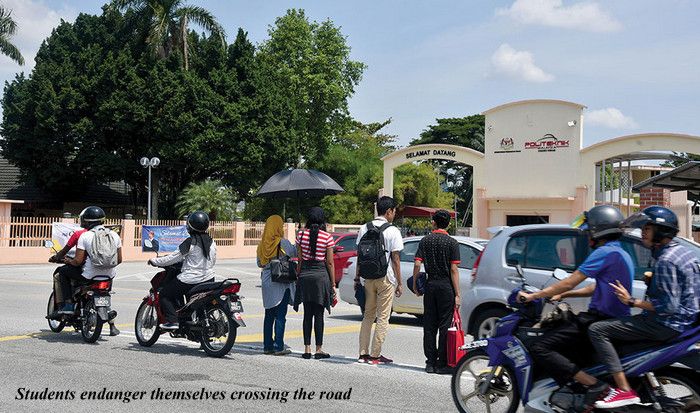

By Nabilah Hamudin
Receiving accolades and attention internationally is no reason for Ipoh to stop recognising its flaws and shortcomings. Plenty more can be done by the authorities and Ipohites alike to improve living conditions of the city’s citizens. In this issue of Ipoh Echo we shall focus on pedestrian-friendly facilities and amenities available for all and sundry.


Poorly-Designed Infrastructures and Their Placements Add to Pedestrians’ Woes
Try taking a walk from Greentown Avenue to Bangunan Persekutuan in Jalan Dato’ Seri Ahmad Said and you’ll find it’s dangerous, one due to the absence of walkways and overhead bridges. It has become a norm for the public to amble across roads and intersections, at the risk of bodily harm, during lunch hours.
Like all transit hubs in Ipoh, Medan Kidd Bus Station, Amanjaya and Ipoh Railway Station, the paved sidewalks from the stations end prematurely without a designated crossing into the business centres on the other side. Pedestrians have to dash across the road causing much distress to passing motorists.
One fine example is in front of Ipoh’s most popular shopping mall, Ipoh Parade. People simply dash across the main road (Jalan Sultan Abdul Jalil) from the City Council building to get to the mall although there is a pedestrian crossing further down the road.
Poorly-designed infrastructures and their placements add to pedestrians’ woes, over and above what they have to endure daily.
Pedestrians’ Perspectives
This scribe walked around the town to check on facilities and spoke to some pedestrians to appreciate their problems.
Thirty-year-old engineer, Ahmad Nazrul Rizal Abdullah, said more crossings and pedestrian bridges need to be built in the city. Such facilities are lacking, especially in business centres.
“The purpose is to provide a safe and comfortable walking experience for those in high pedestrian traffic zones such as Greentown Business Centre. We have trouble crossing roads during lunch hour. There are no connections between buildings, and to make matters worse, there is not even a pedestrian bridge. It’s become a regular sight to see people working here, dashing across the roads to get to the other side.


Student Nur Shariza, 20, who walks frequently to get to places, feels it would a big relief if City Council builds covered walkways for people like her.
“I don’t mind walking on dry days but when it rains, I’ve to seek shelter at bus stops or at shop lots or along corridors before continuing to my destinations. Some pavements are uneven and broken. These cause water puddles to form, making it not only slippery but dangerous. As a student, walking is my only way of going places,” she said.
Nur Farhana Mohd Fairuz, 36, said Ipoh should have more pedestrian crossings and pedestrian bridges to cross roads. She can count the number of pedestrian bridges in the city.
“I’ve only seen one in front of Hospital Raja Permaisuri Bainun and in front of schools. There aren’t many in the city centre, where they’re supposed to be. It’s something that City Council should build because Ipoh is surrounded by pre-colonial buildings and shops. Most of these places don’t have dedicated parking lots. We end up having to park at private parking lots that are located far away. From there we walk all the way to our respective destination,” said the college lecturer.


Disabled Even More “Dis-Abled”
The difficulties caused by the lack of the pedestrian facilities are also felt by the disabled, especially those who are visually impaired.
The Society of the Blind in Malaysia (Perak) chairman Idris Hashim, said Ipoh is supposedly the main public transportation hub in the state but it is so difficult for members to go from one place to another.
“Most of us rely on public transport. We normally board the inter-city buses and hail taxis from Medan Kidd, as it’s the most active point in Ipoh.
“Sadly, there are no tactile pavements or disabled-friendly and modified traffic lights around the area and in Ipoh. It’s very difficult to cross the road with speeding vehicles in Medan Kidd,” he said.
He said blind people often fall into drains and holes when walking around Ipoh. “One of my friends fell into a hole and he ended up in the hospital for treatment. It’s definitely not the first case of such nature,” he lamented.




He urged City Council to erect sign boards or large screens by the roadside to warn motorists to slow down when people are crossing the road.
“Motorists like to speed. They tend to forget people like us, who are differently abled. The signboards and roadside screens can play their role to educate and remind these recalcitrant motorists,” he said.
Idris added that the roadside screen can also play videos on how members of the public can help visually-impaired people cross roads.
“Most of them don’t know how to help us. They pull our clothes; some even pull our cane making it more difficult for us to walk. The screen is necessary. It isn’t really about us, it’s about educating the public,” he said.


Khairruddin Mazli, 26, who lost his ability to see six years ago, suggested that City Council instal traffic lights in Ipoh with sound.
“I stayed in Kuala Lumpur for several years and it was easier to travel on foot, compared to Ipoh. In KL, trains used to be my main mode of transportation. Most of the traffic lights there are built with sounds, hence making it easier for us to know when to cross. Here, there’s no sound, and we don’t know when to cross.
“I’ve also fallen into drains several times in Ipoh but never in KL. It’s normal for me here,” he said.
Ramli Ahmad, 71, said he always asks strangers for help when he crosses roads in Medan Kidd area. “I’m scared to cross the roads at Medan Kidd but that’s the only place where I can get public transportation such as transit buses and taxis. If proper facilities are put in place for us, we no longer have to depend on the public or the kindness of strangers,” he said.
Solutions by Authorities?
Police statistics revealed there were 5472 pedestrians killed between 2007 and 2016. In 2016, 511 pedestrian deaths were recorded in the country with an increase of 29 deaths from the previous year.
While the common solution to curb pedestrian deaths is to have better infrastructure, local authorities struggle with providing relevant infrastructure for reason of low usage.


“Connecting the walkways was part of the long-term plan. But, even if we build them, we’re not optimistic that people would use these facilities. Ipohites are not well-educated when it comes to using pedestrian facilities. For example, many Ipohites prefer to cross the road illegally, even when there is an overhead bridge nearby,” he told this scribe.
However, Zamri agreed that some of these bridges are not suitable for use by senior citizens, the physically differently-abled and parents with babies and small children.
He said another example is zebra crossing. It gives pedestrians special right of way when they are on the crossing.
However, in Malaysia, one cannot assume that cars will stop and respect the rights of pedestrians. It is much safer for one to look at both sides of the crossing before walking as there are motorists who are not law-abiding.
He added that the City Council is planning to build more differently abled-friendly facilities in Ipoh, and one of them is along Jalan Raja Ashman Shah.
“We’ll build more tactile aids on the existing walkways from Klinik Kesihatan Greentown to Angsana Mall, which is about 950m long. Apart from that, we’re planning to build crossings with tactility in the same area,” he said.
Zamri disclosed that to date, Ipoh is equipped with differently-abled-friendly pavements at three locations, namely UTC, along Jalan Sultan Idris Shah and near the visually-impaired centre in Gunung Rapat.
According to MDS Consultancy Group and Traffic Planners and Consultants managing director Dr Rosli Azad Khan, most cities in the country are not pedestrian-friendly. They are mainly designed for motor vehicles.
“When we talk about what is pedestrian friendly, we often forget that it incorporates everyone. We must stop building cities for those aged 30 and athletic-types only. Think of a child aged eight and an 80-year-old person, whether they would be safe if they crossed a crowded intersection.
“Older adults wouldn’t want to walk in the city because there aren’t enough benches along sidewalks, that allow them to rest every few blocks,” he said.


Conclusion
Pedestrians are among the most vulnerable road users, accounting for 22 percent of 1.25 million global road deaths per year, the number one killer of people aged between 15 and 29, according to the World Health Organisation.
Safety is of utmost important when walking in the city. With more cars on urban roads each passing day, crossing them can be a pedestrian’s worst nightmare.
So with all these aforementioned problems, is Ipoh pedestrian-friendly? Your guess is definitely better than ours.


